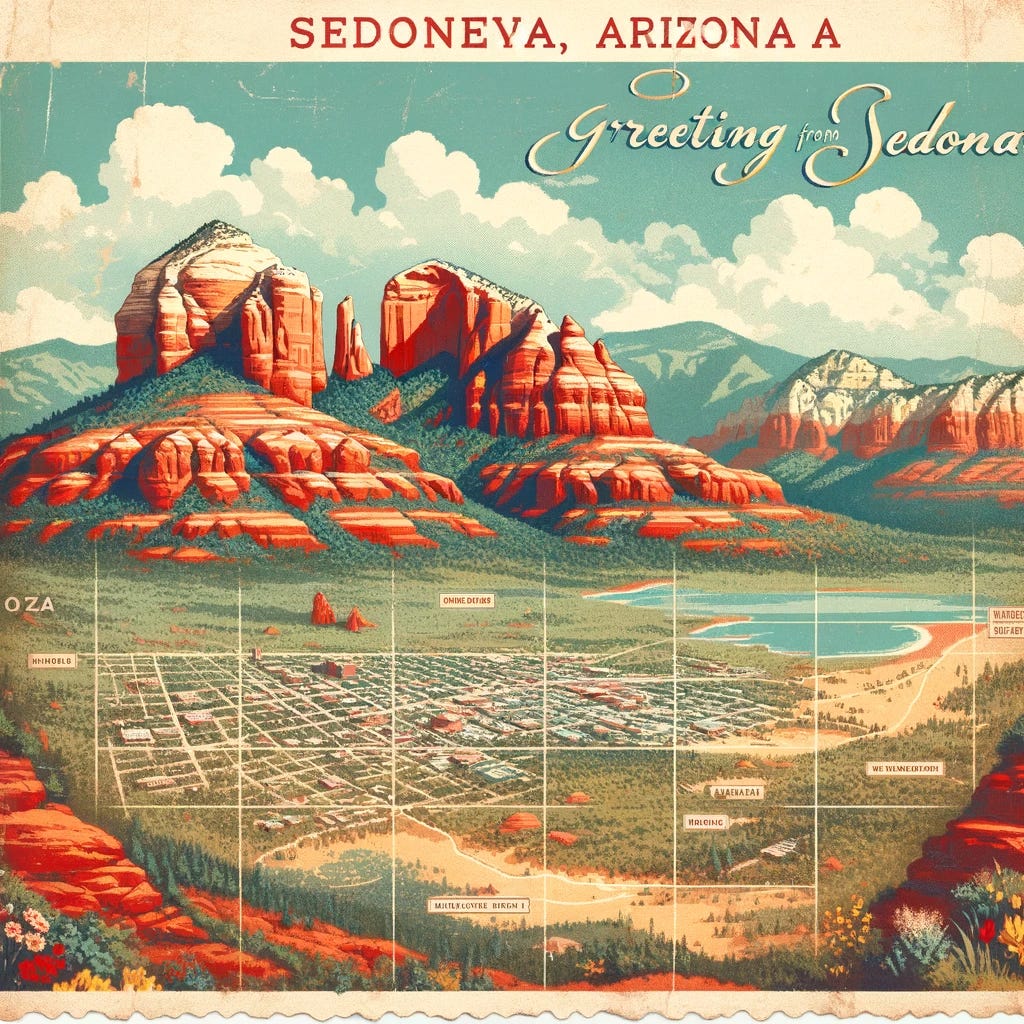Using ChatGPT To Create A "Greetings From Sedona!" Postcard
Another exploration of the power -- and limitations -- of generative artificial intelligence

Google “Devil’s Bridge Sedona” and click through the images. The landscape is stunning, the bridge an adrenaline junkie’s dream. Some of the images are so incredible, it almost looks fake.
While Sarah waited in the queue for her turn on the bridge, I watched from a distance as others approached it. People of all kinds took turns. Young people, old people, children, people in groups, people solo. Some walked, some shuffled, some jumped, and some even skipped — skipped! — across the bridge.
Even from the safety of the not-bridge, my palms sweated and heart raced. The nerves were wracking. On several occasions I caught myself reaching out a hand to those who seemed unsure of themselves, their footing, or the bridge’s integrity. I was holding on to the rock beneath me for their dear life.
It may not always look it in the photos, but I can assure you, Devil’s Bridge is a real place.
We live in a world now where knowing the difference between what is real and what is fake is as challenging as ever. The ability of generative artificial intelligence to create lifelike images and videos is nearly on par with our own today, and getting better every day.
After spending a week chasing Sarah around the beautiful state of Arizona for New Year’s — except onto Devil’s Bridge, I have boundaries — I spent some time last month working with ChatGPT on a way to commemorate the trip. What follows are the results of that work and some commentary on the current state of generative AI.
The Prompt
For this assignment, I wanted to use ChatGPT to create a digital version of one of those vintage “Greetings From …” postcards that you often see at souvenir shops.
It needed to feel like a postcard from Sedona, hence the red and blue color inspiration in the prompt, and be reminiscent of a map in some way. Simple enough, right?
Right?!?
Spelling Issues
OK, first things first: How do you spell S-E-D-O-N-A?
This first example is clearly wrong, but you have to give the AI props here: That second character looks like a new letter of the alphabet, a mash-up of an “E” and a “D” that saves on the overall character count. Brilliant!
Look closely at all of the examples in this post and you will see that the spelling issues do not stop at Sedona. There are misspellings of “Arizona” and even the word “Greetings” on many of the designs, too.
Nonsensical Text
Spelling issues aside, there also is the issue of gobbledygook text that the AI often incorporates into the design.
What is AIIZONO? Or PEDOINA? Or what about that word-like script (top left) near the word “Greetings”?
The concept is clearly there — these are places where a designer might place important text elements — but the application of appropriate text (like actual words) is just as clearly not there.
Map Issues
Given the prompt, the application gets the vibes of Sedona, Arizona right in most examples. Red rocks, blue skies, and a modest city footprint interspersed among loads of greenery. That is, indeed, an accurate representation of Sedona.
What is inaccurate, though, are the so-called maps of Sedona in these graphics. These are fictitious renditions of a city like Sedona, but not exactly Sedona. Take the example below, with its rendition of Sedona that includes the (fake) Great Sedona Lake:
If you are in the market for a more accurate map — emphasis on more accurate because any cartographer will tell you that there is no such thing as a completely accurate map — you still need to employ the services of a human cartographer.
The Best
It took a half-dozen attempts and lots of pleading to create a design with no words at all — feedback that the artificial intelligence ignored repeatedly, by the way — to get what is its best attempt.
There still are issues, obviously. While it did spell the main text correctly this time, the AI included more nonsensical text within the faux postage stamp (see top left). It also cut off both sides of the design, which left the whole thing feeling incomplete.
And that may be the best way to sum up the current state of generative AI when it comes to these kinds of prompts:
Incomplete.








